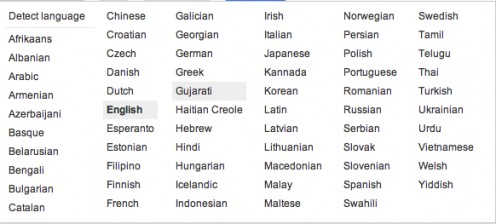6 Reasons Why Google Translate Is My Favorite Online Translator
Thanks to Google Translate, understanding different languages is now a lot easier than it was, say, 10 years ago. Of course, this only applies to written text - anything that you can copy and paste into the tool can be translated in seconds. If you want to translate verbal language then you would need a digital talking translator or a human translator.
Here are the reasons why I love Google Translate:
1) With over 64 languages to choose from, there is simply no getting around the fact that this free online tool covers a significant percentage of the world’s major languages. Translate from English to Chinese and vice versa in seconds or from French – Spanish, Greek – Japanese and many other combinations!

2) The tool is intuitive – if you just randomly copied some text somewhere and you are not sure which language it is, then don’t worry! There’s no need for you to call a polyglot buddy – simply click on “Detect language” on the drop-down for From and if the words you’ve pasted matches a language on Google’s database then you’ve got yourself a translated version in seconds! If the language is not there, then you are welcome to call on your polyglot friend. :-)

3) Google Translate remembers the last 3 input languages and 3 output languages. For example, on the From drop-down you selected English, Japanese and Spanish and on the To drop-down you selected German, Spanish and Czech. You can click on any of the output languages and the translated words will be displayed on the results field. Here’s a screenshot when I clicked on the German translation:

If you want to view the Spanish and Czech translations of the input text “Hello have a good morning” then you simply need to click on Spanish and Czech respectively.
4) View alternate translations by hovering your mouse over the text you want to see alternate translations to. In the example above, if you hover over “haben einen guten” the following alternate translations will appear:
eine gute
haben eine gute
einen guten
ein gutes
Of course, I have no idea if the original translation is correct since I don’t know a word of German! Neither can I confirm that the alternate translations are correct as well. But the point is that it is at least possible to get an idea of what the translated text is!
5) You can listen to the translated text. This would prove useful if you want to know how your translated text sounds. Again, this should only serve as guide. Google translator is not perfect – for the proper accent, intonation, etc of the target/output language it would be best to seek the services of a human translator!
6) Rate the translation. If you are at least familiar with the output language, then rating it would be a breeze. This would at least give Google some feedback on the tool if the translated text has been helpful, not helpful or offensive. If you do not know the language then I wouldn’t suggest rating it!
These points are just my opinion. Using this free and wonderful tool should be used with a grain of salt. You can try translating from English to a language you at least know, for example, Spanish, and you can see for yourself that the tool does not always display accurate results. If you are writing an academic paper or if you are looking into translating some serious text, like government papers, etc, then don’t use Google Translate. If you only want to know the rudimentary meaning of a foreign word or phrase for fun, then Google Translate would be perfect for your needs!








